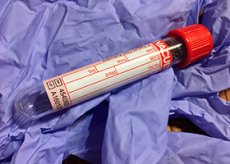
All iLive content is medically reviewed or fact checked to ensure as much factual accuracy as possible.
We have strict sourcing guidelines and only link to reputable media sites, academic research institutions and, whenever possible, medically peer reviewed studies. Note that the numbers in parentheses ([1], [2], etc.) are clickable links to these studies.
If you feel that any of our content is inaccurate, out-of-date, or otherwise questionable, please select it and press Ctrl + Enter.
General blood test in pregnancy
Medical expert of the article
Last reviewed: 07.07.2025

A general blood test during pregnancy is the simplest test prescribed to all expectant mothers. The main indicators of this test provide information about the percentage of platelets, erythrocytes, leukocytes in the blood, the level of hemoglobin and ESR. These indicators indicate the health of the pregnant woman and how the pregnancy is progressing.
Based on the general analysis data, you can find out about a hidden inflammatory process in the body, the onset of anemia, allergies, helminthiasis and other changes that affect the percentage of formed elements in the blood. This is the simplest and fastest method for diagnosing physiological changes at an early stage. For pregnant women, the following standards are established for a general blood test:
- The normal hemoglobin level is 120-150 g/l.
- The normal leukocyte count is 4.0-9 x 10 9 cells/l.
- The normal level of erythrocytes is 3.5-4.5 per 10 12 cells/l.
- The platelet norm is 150-380 per 10 9 cells/l.
- The normal ESR during pregnancy is up to 45 mm/h.
A general blood test during pregnancy should be taken at least three times throughout the pregnancy. The first time is when a woman registers, then at 20 and 30 weeks of pregnancy. It is better to take blood in the first half of the day, after eating a light breakfast.
Who to contact?
Decoding blood tests during pregnancy
Decoding a blood test during pregnancy will provide information about norms and deviations. The norm is considered to be a fluctuation in hormonal balance and formed elements in the blood. Glucose normally remains at a constant level during pregnancy, sometimes slightly increasing or decreasing - this is due to hormones produced by the placenta.
Increased iron consumption during pregnancy (serum ferrin and iron in the blood decrease) can provoke the development of anemia in the pregnant woman. In addition, the level of vitamins and minerals decreases. The need for calcium and phosphorus increases especially; in some cases, acute calcium deficiency may develop, accompanied by hypoproteinemia.
The number of platelets may vary at different stages of pregnancy, depending on the physiological characteristics of the expectant mother's body - 150-380 per 10 9 per l. Red blood cells in the blood of a pregnant woman are normally contained within 3.5-4.5 per 10 12 cells/l.
The number of leukocytes in a general blood test during pregnancy can increase to 15.0 per 10 9, and many leukocytes also accumulate in the body of the uterus to minimize the likelihood of infection penetrating the fetus. The erythrocyte sedimentation rate also increases, with rates of up to 45 mm/h typical for pregnant women.


 [
[